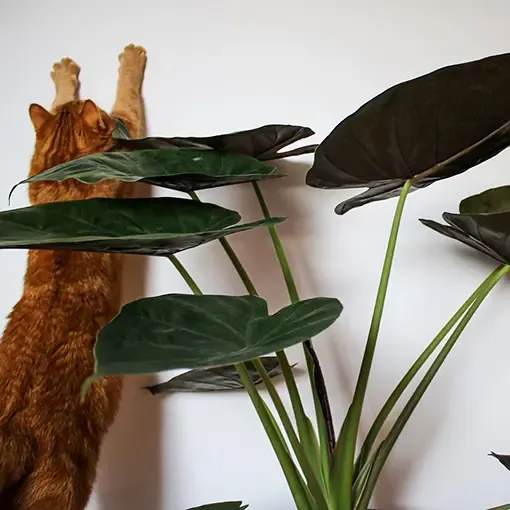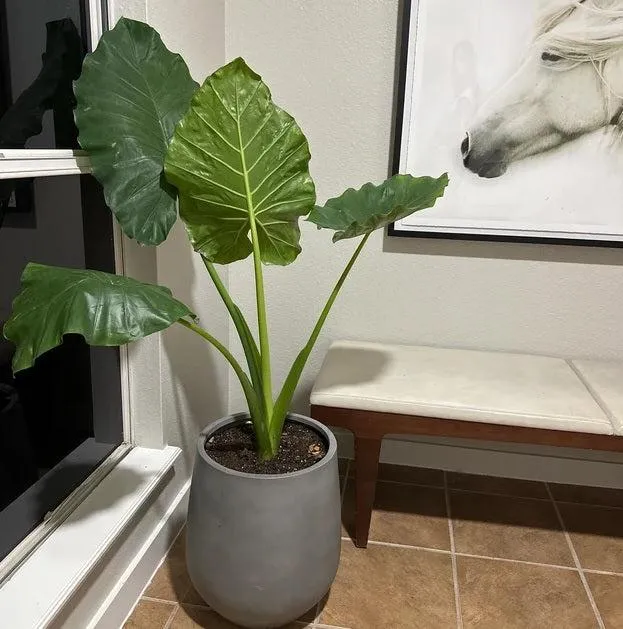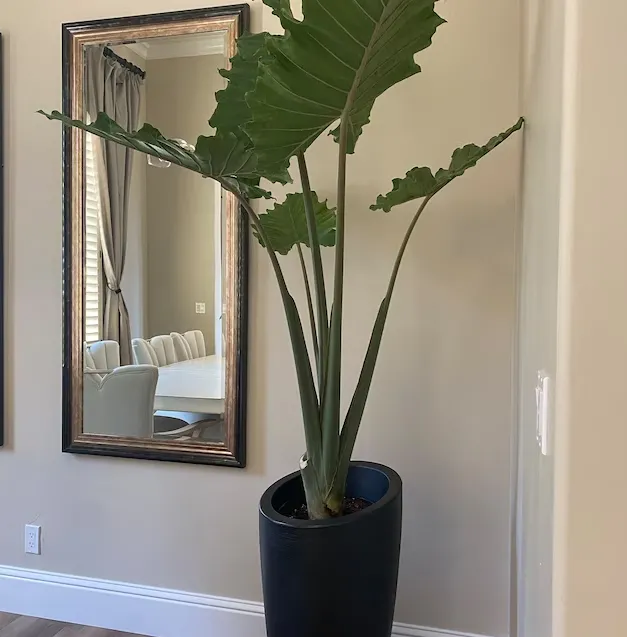Can You Keep Alocasia Plants with Cats?
If you’re a cat owner interested in adding some houseplants to liven up your home, you may be wondering whether alocasias are cat-friendly. Alocasias, also known as African masks plants, are tropical plants known for their large, interestingly shaped leaves. However, their toxicity means you need to take certain precautions if keeping them around cats. In this article, I’ll explore the issues involved and provide tips to help keep your cats safe.
Are Alocasias Toxic to Cats?
The short answer is yes – all parts of the alocasia plant are potentially toxic to cats if ingested. The main concern is the oxalate crystals found throughout the plant. If eaten, these crystals can cause issues such as:
– Mouth and digestive tract irritation
– Vomiting and diarrhoea
– Swelling of the mouth and throat (which could potentially obstruct breathing)
– Kidney failure
While cats may be drawn to investigate plants due to curiosity or a prey instinct, they usually need to consume a sizable amount of plant material for it to become an emergency. However, even ingesting a small amount could cause discomfort. So it’s best to assume that any contact with an alocasia poses some level of risk.
Ways Cats May Interact with Alocasias
- Chewing or eating the leaves – Cats may see large, curious plant leaves as toys to play with and potentially bite or ingest parts.
- Knocking plants over – Curious batting or jumping could cause an alocasia to topple over, spilling soil and releasing possible toxins.
- Drinking contaminated water – Toxins may leach into the soil and be absorbed by roots. Cats drinking from plant saucers could ingest these.
- Tracking soil/plant material – Paws contacting soil or sap could transport traces that are then ingested through grooming.
How to Keep Cats Safe Around Alocasias
While alocasias look stunning, their toxicity means extra precautions are needed if keeping them alongside cats. Here are some tips:

- Consider a different type of cat-safe plant. Non-toxic options include spider plants, peace lilies or English ivy.
- Use sturdy plant stands instead of putting alocasias on the floor or low surfaces cats can access.
- Secure pots by adding stakes or weights to stop cats knocking them over.
- Place plants in tall vases or hang them where leaves are out of reach.
- Use natural or spray deterrents around plants to discourage investigation like citrus or hot pepper around the pot rim.
- Always wash hands well after touching plants before any cat interactions like petting or feeding.
- Be especially vigilant with new kittens or curious cats prone to chewing. Consider plants only once cats are older.
I’ve found positioning plants so the leaves are level with or higher than door frames helps – cats can leap as high as this in one jump! Empty any standing water from saucers and wipe down leaves periodically to minimize contamination risks.
What to Do if a Cat Ingests an Alocasia Plant
Despite prevention efforts, accidents may still occur. If you see a cat chewing or swallowing parts of an alocasia, time is critical:
- Contact your vet right away and bring a sample of the plant for identification if possible.
- Induce vomiting using hydrogen peroxide if it’s been under 30 minutes and follow vet advice on dosage.
- Watch for signs like vomiting, increased thirst, lethargy or trouble urinating that may indicate kidney involvement.
- Be prepared for follow ups and potential treatment like IV fluids or medications to eliminate plant toxins.
- Consider activated charcoal to absorb any remaining toxins if given soon after ingestion, following vet guidance.
If in doubt, it’s always best to assume a poisoning occurred and get veterinary assessment as soon as possible. Early treatment greatly improves outcomes.
Creating a Safe Plant Environment
With proper care and planning, it may be possible to enjoy alocasias along with feline companions. But cats will be cats, so potential harm from accidental contact can’t be ruled out entirely. For safety’s sake, it’s wisest to avoid plants toxic to cats if they show interest in potentially ingesting greenery.

An idea is keeping less curious cats and toxic plants strictly separated – for example, in different rooms with closed doors. Overall though, choosing non-poisonous houseplants provides one less worry when living with our furry best friends.
I hope this overview of alocasia toxicity was helpful for anyone pondering these dramatic plants alongside their furry family members. With awareness and precautions, a happy compromise may still be possible. But cat health has to be the top priority in any plant decision. Please let me know if you have any other questions!
Things to Know About Alocasia Plants and Cats
| Plant | Toxicity Level | Symptoms if Ingested |
|---|---|---|
| Alocasia | Moderately Toxic | Vomiting, diarrhea, decreased appetite |
| Polka dot plant | Moderately Toxic | Drooling, vomiting, diarrhea |
| Elephant ear | Low Toxicity | Mild gastrointestinal upset |
| Chinese evergreen | Low Toxicity | Drooling, vomiting, diarrhea |
| Peace lily | Low Toxicity | Mild vomiting, diarrhea |
FAQ
-
Is it okay for cats to be around alocasia plants?
Generally, it’s not a good idea for cats to interact with alocasia plants. While the plants themselves aren’t poisonous, the sap can sometimes irritate a cat’s skin if they rub against it. So to be safe, it’s best to keep cats away.
-
Will cats try to eat alocasia leaves?
Cats may be tempted to nibble on the large, arrow-shaped leaves of alocasia plants. Although the leaves aren’t toxic, they wouldn’t give much nourishment. There’s also a risk the sap could irritate a cat’s mouth. So it’s a good idea to keep alocasia plants out of reach of curious cats.

-
What should I do if my cat eats part of an alocasia?
If your cat does chomp on an alocasia leaf or stem, don’t panic – the plant material itself isn’t very harmful. But you may want to watch for signs of skin irritation around the cat’s mouth. Give them a thorough check-over and rinse with water if any sap is visible. And contact your vet right away if any rashes or discomfort appears to be ongoing. With any plant ingestion, it’s always better to err on the side of caution.
-
Can I put alocasia plants in a room with outdoor access for cats?
While alocasia plants are safe once fully grown, it’s still best to keep them out of direct reach of cats – even ones that spend most of their time outside. It may not seem like a big deal if Fido snags a leaf, but these plants can irritate delicate kitty skin. So if outdoor cats can access the room, it’s usually better to put alocasias in a higher spot like a tall bookshelf – just to be on the safe side. Your furry friends’ health isn’t worth the risk.
-
What precautions should I take with cats and alocasias?
For the well-being of curious cats, take some basic precautions with alocasia plants. Keep them sheltered high up or behind baby gates where paws can’t reach. Consider covering the soil surface too since cats sometimes like to nibble in the dirt. Routine cleaning also prevents licking of residue. With a little care, you and your alocasia-loving kitties can live together plantfully!
By following some common sense measures like those outlined above, you can safely grow gorgeous alocasia plants even with feline friends underfoot. The key is simply discouraging access and interaction, while still providing pets with ample safe spaces. With some minor adjustments, there’s no need to choose between your leafy exotic beauties and furry companions. Hope this helps put your mind at ease! Let me know if any other questions come up.

